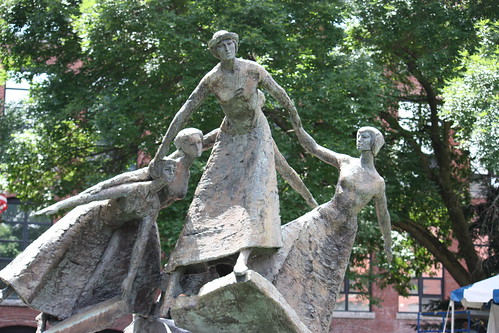Impressions of Lowell: 20 Months and Counting

Impressions of Lowell: 20 Months and Counting
By Emily Ferrara
A recent addition to our Literary Lowell roster, Emily Ferrara writes about her initial impressions of Lowell:
I once wrote a poem that referenced “the smokestacks of Kerouac’s Lowell”, but it was only a fleeting image in a journey to the sea. I had never visited the city despite all the years I’ve lived in Massachusetts, and all the road trips up 495 as I headed to favorite beach-haunts on the North Shore and in Maine. So when my wife waxed enthusiastic, I agreed to relocate here to be closer to her job and to the coast. The slogan, #Lowell: There’s a lot to like, kept my expectations modest.
As a relative newcomer, a blow in from Bridgeport, Connecticut by way of Worcester, I want to qualify myself: I’m a product of a gritty post-industrial city, whose official nickname “The Park City” had become a tongue-in-cheek moniker by the time I was in high school. When I left Bridgeport in 1976, it was plagued by creeping urban blight, political corruption, and growing socioeconomic and racial disparities.
Bridgeport has never recovered from the decline, and for that, I mourn its aborted rebirth. These hometown origins set the stage for my experience of Lowell as legend of resurrection, restoration, and reinvention.
I don’t mean to sound like a Chamber of Commerce brochure, but my first impressions were similar to that of a tourist drawn to the city for its designation as a National Historical Park, its recognition as “The Cradle of the Industrial Revolution” preserved as a living museum. Downtown is wonderfully walkable, dotted with art galleries, museums and restored mill buildings. The ethnic diversity is reflected in the many eateries, mom-and-pop shops, independently-owned businesses selling edible and wearable imports.
I’m sure the Chamber would have left out my story of the night we moved into our apartment in the Hamilton Canal District. On my last run from the Early Garage balancing miscellaneous belongings and my new key fob, I stepped into the alcove at the front door to find a man with his pants down. Drunk but gentlemanly, he apologized for the indiscretion, pulled up his trousers and moved on. It seemed a fitting christening of my first night as a Lowell resident
And yet, I fell in love! With the confluence of the Concord and Merrimack Rivers. Sunset walks across the green steel “Bridge Street Bridge.” I reveled in reciting neighborhoods by name, The Acre, Lower Highlands, Little Canada, Christian Hill, Pawtucketville, Belvidere, Cambodia Town. My dog and I admired public art installations—Human Construction, Homage to Women, The Worker, and Industry, Not Servitude—as we walked our familiar path along Central and Market Streets to Lucy Larcom Park. Most especially I fell for the people who breathe life into every brick and cobblestone, alley and green space, and never put on airs.
Ever since those first few weeks and months of infatuation, I’ve been weaving myself into the fabric. I’ve thrown quarter-weighted dollar bills at the Warp & Weft ceiling to raise funds for the Arts League of Lowell. Kept the Club Diner open past its mid-day hours with my enthusiasm for friendly conversation, a perfectly grilled corn muffin and bottomless cups of coffee. At Winterfest, I staffed the Carousel with a carnival roadie and a young engineer working for a local start-up. I’ve taken classes in painting and photography, and in my studio at Gates Block, I created a piece of art titled “Here, and Then Gone”—featuring a 1960 issue World Refugee Year stamp from my father’s collection—for the Annual 4×4 fundraiser at The Brush.
Most recently I’ve dug beneath the surface and begun to get a glimpse of Lowell’s shadow side. Because no place is without its grit and grievances, its hard realities. In particular, I’ve become increasingly aware of the needs and concerns of our immigrant and refugee populations. Later this week, I begin Empower Training, a workshop series sponsored by the Lowell Alliance and Coalition for a Better Acre. The series offers “knowledge, skills and resources to help create and lead grassroots change.”
I’ve made a commitment to Lowell. And like any intimate relationship, once the newness wears off, there is a chance to deepen the connection, to embrace challenges and engage in difficult conversations, to be teachable. I vow to keep my heart and mind open to Lowell in all its many guises and manifestations.
Welcome to the city!
Welcome, Emily! I look forward to hearing more from you.
Welcome, Emily. Bob Forrant and Richard Howe are wonderful historians. Many Lowellians are welcoming and just plain wonderful! Some have lived in Lowell all their lives and have not explored as much as you have already! Welcome!
Beautifully written, wide-ranging observations.
Welcome Emily! Thank you so much for volunteering your time at Winterfest and for helping us out with the Carousel. I really enjoyed reading your piece, thank you for sharing!
I love your article. I want to return to Lowell in warmer weather to see more of it. What I have seen is great. I love the history.
Nicely done! Positive appreciation of a city whose reputation is not always acknowledged! Thank you for taking the time to know her. She is an enigmatic entity!
Fantastic piece. The imagery you paint with your beautiful words is captivating. Can’t wait for our next visit when you can show me some of these places in person.
We are also newcomers having moved here one year ago. I echo your feelings. Lowell suits us well and we too have made a commitment to the city.
You’re going to love the Empower program! ❤️